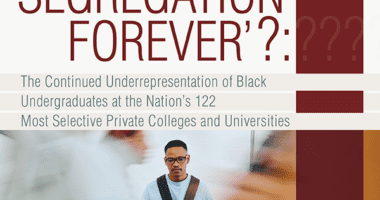The Impact of George Floyd’s Murder: One Year Later
George Floyd’s death on May 25, 2020, at the hands of Minneapolis police sparked a wave of protests against police violence and racial injustice around the U.S. Meanwhile, the pandemic was taking its harsh toll on communities of color, underscoring the stark socioeconomic inequities between White and Black, and picking the scab of the persistent racial challenges still facing the nation.
In the ensuing months, Americans engaged in tough, and, for many, painful conversations about systemic racism in American institutions, including in our public schools and colleges. Students, parents, and advocates urged K-12 boards and college administrators to create more welcoming spaces by diversifying faculty and staff, severing ties with police and adding more mental health experts, stripping buildings of names and dismantling statues associated with slavery, making curricula more inclusive, and including underrepresented voices on boards and committees. In response, many schools and colleges issued statements affirming their commitment to racial equity and calling for change.
One year later, officer Derek Chauvin was convicted of Floyd’s murder — a small step toward progress. But what headway has been made on educational justice?
While leaders and educators are discussing racial issues more openly, and there have been scattered reforms — particularly around campus and school policing (e.g., at the University of Minnesota and school districts in Denver, Minneapolis, Oakland, and Portland, Oregon, which cut some ties with local police) and the renaming of buildings (e.g., at universities and schools in Virginia, California, and elsewhere) — these efforts are largely piecemeal or symbolic and may, ultimately, do little to reverse the underlying systemic racial inequities in education that date back to the days of segregation and slavery.
A recent survey of college students, conducted by Inside Higher Ed and College Pulse, seems to support that view. While two-thirds of respondents say colleges ought to play a part in promoting racial justice and equality, and nearly 6 in 10 (57%) say race is being discussed more often on campuses, many feel that substantive change is meeting with resistance or occurring more slowly than many of them — especially student activists and students of color — would like.
A similar dynamic is playing out in the nation’s public schools, where the student body is increasingly Black and Brown, while the teaching force remains overwhelmingly White. And students, all of whom would benefit from having diverse teachers as role models, often go through school without ever interacting with a Black or Latino teacher. Debates about introducing race-conscious and culturally relevant curricula in schools are “hot,” but political controversy and the culture wars are complicating efforts to make courses more inclusive.
Meanwhile, students’ mental health has eroded amid the pandemic — which has imposed financial hardships and food insecurity on many families, particularly those of color, and forced many schools to operate remotely — and gaps in opportunity and achievement among students who were already getting short shrift before the outbreak have widened. While the latest federal relief package includes nearly $125 billion for K-12 education — about $109 billion of which will go directly to local school districts — there’s still a pressing need for additional funding for initiatives designed to meet the social, emotional, and academic needs of those students most impacted by the pandemic, and to support the educators working tirelessly to help those students while struggling to overcome their own hardships.
The pandemic has also heightened the struggles of college students facing financial hardships and college students of color. According to the National Student Clearinghouse, college enrollment rates among Black and Hispanic students fell precipitously last fall — particularly at community colleges, which serve a large share of students of color. That threatens to derail efforts to boost educational attainment among Black adults — which, before the pandemic, was the same as it was for White adults in 1990 — and Hispanic adults, which lagged behind White adults but was on the upswing (especially among Latinas).
The country can ill afford to let America’s racial and ethnic educational divides deepen at a time when having a college education is all but essential in the workplace and rising college costs have made it nearly impossible for many low-income students and students of color to get a degree without going into debt. The Black student debt crisis, which will only widen the black wealth gap if unsolved, remains particularly acute.
If ever there was a time to cancel student debt, double the maximum Pell Grant, and create federal-state partnerships for debt-free college, this is it.
There are reasons to be hopeful that federal and state leaders will address racial disparities in education. Late last year, Congress finally lifted the decades-long ban on Pell Grants for students who are incarcerated — many of them Black and Latino students. And state lawmakers in Maryland successfully made good on a promise to more equitably fund the state’s four historically Black colleges and universities, a move that could go a long way toward rectifying longstanding racial attainment disparities in the state.
But we cannot let up on the pressure. Let the anniversary of George Floyd’s death be a reminder of the need for meaningful action. Discussions, statements, and symbolic gestures are only starting points for discussions on how to dismantle systemic racism in American education; but without follow through, these efforts are performative at best. Rest assured that all of us here at The Education Trust — with the help of students, families, and advocates — will keep pushing for more inclusive curricula, diverse educators, fair funding, and other policies that advance equity, while calling out those (e.g., around harsh discipline) that are detrimental to students of color, and working to hold education administrators, leaders, and policymakers accountable for making American schools and colleges accessible and equitable for all students.











